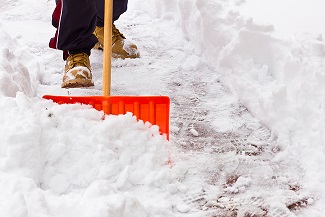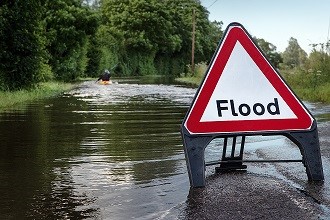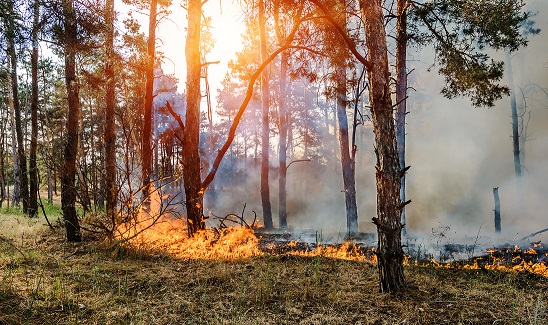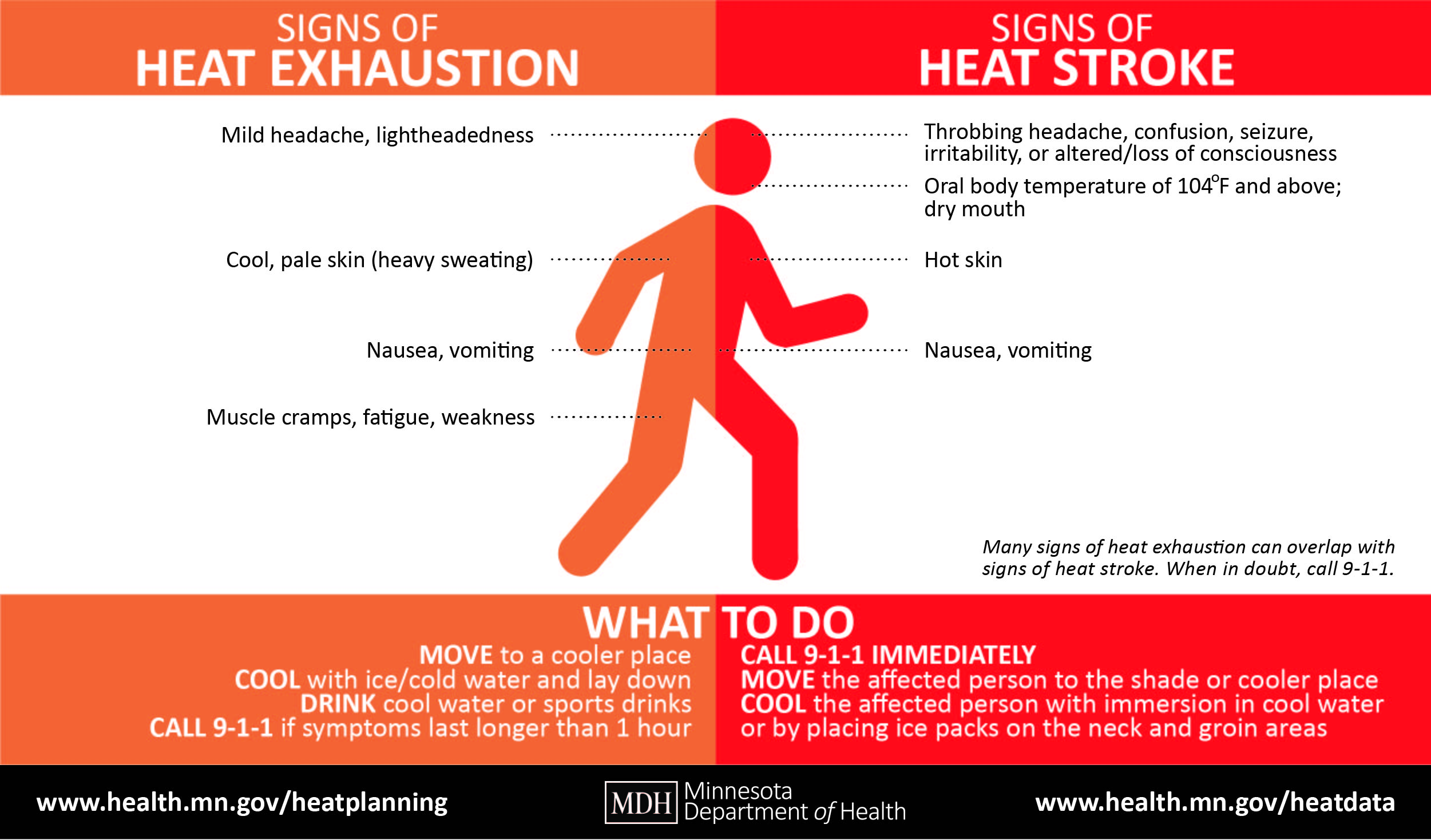Natural Disasters and Severe Weather
Related Site
Environmental Health Division
Natural Disasters and Severe Weather
Disasters can happen anywhere, at any time, often with little or no warning. Minnesota experiences a wide variety of weather conditions that can affect our health. By preparing your family, your home and your car in advance and by observing precautions during times of extreme weather, you can reduce the risk of health problems.
 Minnesota is known for our cold and snowy winter weather but staying warm and safe can be a challenge.
Minnesota is known for our cold and snowy winter weather but staying warm and safe can be a challenge. Floods: Floods are among Earth's most common–and most destructive–natural hazards.
Floods: Floods are among Earth's most common–and most destructive–natural hazards. Tornados: Knowing what to do when you see a tornado, or when you hear a tornado warning, can help protect you and your family.
Tornados: Knowing what to do when you see a tornado, or when you hear a tornado warning, can help protect you and your family. Wildfires: Wildfires are becoming larger and more frequent in the United States and Canada, in part due to the influence of climate change.
Wildfires: Wildfires are becoming larger and more frequent in the United States and Canada, in part due to the influence of climate change. Extreme Heat Events: Extreme heat in Minnesota are already occurring and are expected to become more common, more severe, and longer-lasting as our climate changes.
Extreme Heat Events: Extreme heat in Minnesota are already occurring and are expected to become more common, more severe, and longer-lasting as our climate changes.Before a disaster
Have an Emergency Plan
Review and update your emergency plan, telephone numbers and e-mail addresses for family, friends, medical, veterinary, and other services you may need.
You may also want to inquire about emergency plans at places where your family spends time like work, daycare and school.
Put Together an Emergency Kit
Check and resupply your emergency kits regularly.
During a disaster
Did you know that a flood, fire, national disaster, or the loss of power from high winds, snow, or ice could jeopardize the safety of your food? Knowing how to determine if food is safe and how to keep food safe will help reduce the risk of foodborne illness and minimize food waste.
- Only use water that is known to be safe
- Wash hands frequently
- Wash surfaces that contact food before and after each use
- Throw out food that may be unsafe
Do not eat unsafe food
Food is usually safe unless it touched floodwater or was not kept cold. Throw out food or drink if:
- It is likely to spoil
- Has an odd odor or color
- It touched floodwater and is not in a waterproof package
- It has a screw cap or “pop top”
- It’s can is rusted, swollen, leaking or badly creased or dented
Cans that aren’t damaged may be saved. First:
- Take label off
- Wash with soap and clean water
- Sanitize using bleach
- Write the product name and expiration date on the can
When in doubt, throw it out!
Keep cold foods cold
Throw out refrigerated or frozen food if it has been:
- Above 41° F for 4 hours or more or
- Thawed for 2 hours or more
If you lose power, a refrigerator will keep food cool for 4-6 hours if you keep it closed. Food will stay frozen for one day in a freezer, that is half-full and kept closed; or up to 2 days if it is full.
MDH Resources
Many people want to help during a disaster. They may want to bring food for residents and workers. However, food from a home is not acceptable. It is hard to be sure that food from a home will not result in foodborne illness.
People in a disaster can be at greater risk for getting sick from unsafe food. Safe food donations can help avoid foodborne illness.
Usually donations can become a hassle for resource management during disasters. Resources to donate can be found at Volunteers and Donations (HSEM).
Disaster feeding centers use trained food workers to serve safe food to groups. They make sure the food and drink they obtain, prepare, and serve is safe. They use equipment that helps keep food safe.
Finding and equipping a mass feeding site
Only use safe water for drinking, cooking, making ice or baby formula, washing hands and dishes. Water that has been impacted by flood water is most likely not safe.
The safest water is bottled water from stores or your local emergency center. Local officials can tell you how to get safe water after an emergency.
Well water safety
A flooded water well can make well water unsafe to use. Do not use water from a flooded water well for:
- Drinking
- Cooking
- Making baby formula
- Making ice
- Brushing teeth
- Washing dishes
- Showering or bathing
You can use water from a flooded well to flush toilets if needed.
Do not use water from a flooded well until the water has been tested and/or disinfected.
MDH Resources
Confined space danger
Disasters may create dangerous conditions in confined spaces.
For example, water damaged and hazardous materials left behind may make the air in a basement or enclosed room hazardous. Also building damage may block entry and exits or expose other dangers.
A confined space is anywhere that:
- Has few openings in or out
- Has poor air flow so contaminants may build up
- Could collapse or trap someone inside
Examples of confined spaces include: storage tanks, pits, ducts, sewers, tunnels, underground utility vaults, pipelines and others.
Use care in any confined space
Do these things if you have to enter any confined space:
- Make sure the space is safe from collapse
- Make sure utilities (electricity, gas, and water) are shut off
- Make sure outdoor air is flowing into the space
- Have a way to signal for help
- Exit immediately if any unsafe conditions develop
Contaminated air
- You cannot trust your senses to identify all hazards in a confined space
- You may not be able to see or smell many contaminants in the air
- You cannot tell if there is enough oxygen for you to breathe
If dangerous conditions (airborne contaminants or low oxygen) could be present, special equipment is needed to determine if the air is safe.
If in doubt, do not enter
Never enter a confined space unless you are sure it is safe.
Do not enter a confined space to rescue others unless you are trained for emergency rescue and have the tools and equipment for the job. Otherwise, you could become the next victim!
What is carbon monoxide?
Carbon monoxide is a gas. It has no odor, no color and no taste. Sometimes it is called the “silent killer.”
Carbon monoxide can be a problem after floods. People sometimes use portable generators for making power. Other gas powered tools are often used for cleaning.
NEVER use a generator, fuel-powered tools, gas or charcoal grill in the house, garage, in enclosed areas, or near windows, doors, vents, window air conditioners, and other openings.
Portable gasoline-powered engines that can generate power, pump water, or provide other essential services during a power outage produce significant amounts of carbon monoxide, which is dangerous to your health.
Symptoms of carbon monoxide poisoning
The most common symptom of carbon monoxide poisoning is:
- Severe headache
Carbon monoxide may also cause:
- Severe fatigue
- Weakness
- Chest pain in those with heart disease
- Shortness of breath
- Nausea
- Vomiting
- Confusion
- Lack of coordination
If not removed to fresh air, carbon monoxide can cause loss of consciousness and death.
If you start to feel sick or dizzy while using fuel-burning equipment, get to fresh air right away.
DO NOT WAIT!
Buy and install a carbon monoxide alarm
Minnesota Statutes, section 299F.50 requires that homes have a carbon monoxide alarm within 10 feet of every room used for sleeping. This is effective for all single and multi-family homes.
MDH Resources
People have always taken care of each other in times of trouble. Helping people clean up after a disaster is part of that tradition. But clean-up work can be hazardous, so it's important to take care of yourself.
After a disaster
Why should I be concerned?
Asbestos is a naturally occurring mineral fiber. More than 3,000 different construction materials and manufactured products used asbestos. Homes and businesses had asbestos products installed as part of new construction or remodeling through the late 1980s. When asbestos-containing materials are disturbed, the asbestos breaks down into very fine fibers. These fibers can become airborne and trapped in lung tissue when breathed. Asbestos fibers can cause lung scarring and cancers, 30 years after exposure. There is no known safe level of asbestos exposure. Because of this health threat, it is highly recommended that flood damaged asbestos-containing material is repaired, enclosed, encapsulated or removed. Any removed asbestos-containing material must be properly containerized and disposed of at a landfill approved to accept asbestos-containing material.
What materials contain asbestos?
How do I find out if it's asbestos?
Check for asbestos markings on the material or its packaging. If there are no markings or you cannot find the original packaging, hire a Minnesota certified asbestos inspector to sample the material or perform an asbestos inspection. Contact the MDH Asbestos Program for additional information.
How do I dispose of asbestos?
Since asbestos is a hazardous material, it must go to specific landfills. The Minnesota Pollution Control Agency (MPCA) maintains a list of landfills accepting asbestos waste. See Asbestos in demolition or renovations.
There is flood-damaged asbestos in my home/building
Homeowners may legally repair, encapsulate and remove asbestos themselves, but only from the single-family residence, they own and occupy. However, MDH strongly recommends hiring an asbestos abatement contractor to do this work for the protection and safety of the occupants of the home. Contractors must be licensed by MDH as an asbestos abatement contractor to enclose, encapsulate or remove asbestos-containing material. Asbestos abatement contractors employ state-of-the-art techniques to handle the asbestos safely. The asbestos abatement contractor also performs air monitoring to ensure that the air in the building meets acceptable standards at the end of the project. Removing the material may be the best option. Especially if the asbestos-containing materials is extensively damaged or if it will be disturbed.
My home/building has to be demolished due to flood damage
Homes or buildings scheduled for demolition must have friable (easily breaks down) asbestos-containing material and certain other forms of asbestos-containing material removed before demolition. Friable asbestos-containing material must be removed by a licensed asbestos abatement contractor. In certain situations when asbestos-containing material cannot be separated from the demolition debris, the contractor may transport and dispose of the debris as bulk asbestos containing waste.
MDH Resources
Safety first
Before entering a building, take care to be safe. Watch for loose plaster, drywall, and ceilings that could fall.
Wear sturdy shoes
Use battery-powered lights
Use battery-powered lights or flashlights if you need light for a short time.
Look for fire hazards
Fire is the most common hazard after floods. Look for:
- Broken or leaking gas lines
- Flooded electrical wires
- Furnaces and electrical appliances that are under water
- Items that can catch fire or explode
Check for gas leaks
If you smell gas or hear a blowing or hissing noise:
- Quickly leave the building
- Turn off the gas at the outside main valve if you can
- Call the gas company from a remote location
If you turn off the gas for any reason, a professional must turn it back on.
Look for electrical damage
DO NOT step in water:
- If you see sparks, broken or frayed wires
- Smell burning insulation
- To turn off the electricity
Call an electrician to help.
If you can safely reach the fuse box or circuit breaker, turn off the electricity.
Pump basement water
Pump floodwater out of a basement slowly.
Pump about one-third of the water each day to avoid damage to basement walls. Pressure from water in the soil outside the walls can break walls if you pump too fast.
Floods may increase insect numbers
Many types of disasters, including floods, may present increased chances of insect bites.
Standing water left by a flood can make mosquito numbers rise. Greater river flow can lead to larger numbers of black flies and biting gnats. Other insects, such as wasps, may become very aggressive.
Disease risk is low
Only some mosquitoes and ticks can cause disease in people, and not all of these actually carry disease.
Usually the risk of such diseases often goes down right after a flood. This risk may go up in later months or years.
To protect against bites
- Wear insect repellent
- Wear long-sleeved shirts and pants—light colors may reduce mosquito and black fly bites and make it easier to see ticks
- Avoid outdoor activity at peak mosquito feeding times (dawn and dusk)
- Remove containers that hold water (buckets, tires, etc.) from your property
Safe and effective insect repellent may contain:
- Up to 30 percent DEET
- Picaridin, oil of lemon eucalyptus, or IR3535 can protect against mosquitoes
- Permethrin can be used on clothing (not skin) to kill mosquitoes and ticks
MDH Resources
External Resources
What is mold and why can it be a problem after a disaster?
Mold is a kind of microscopic fungus. There are many types of molds, and they are present throughout the environment, indoors and out. Tiny mold particles are always present in the air, in the form of tiny microscopic cells known as spores.
Mold spores can germinate and grow in a moist or damp environment, on any surface that contains organic matter. A home that’s been flooded can provide ideal conditions for the growth and proliferation of mold.
Mold can grow within 12 to 24 hours after a flood. Mold can make some people sick, like when they have an allergy (stuffy nose, sore eyes).
Why is mold a health concern?
Indoor mold can trigger allergies or allergy-like symptoms affecting the upper respiratory system. Although other, more serious problems may occur if people are exposed to very high levels of mold, the most common complaints are:
- Nasal and sinus congestion
- Cough
- Wheeze/breathing difficulties
- Sore throat
- Skin and eye irritation
- Upper respiratory infections (including sinus infections)
The effect of mold on different people can vary widely. However, long-term exposure to high levels from indoor mold growth can eventually be unhealthy for anyone. The following groups of people may be at greater risk than others:
- Infants, children and the elderly
- Individuals with respiratory conditions or sensitivities such as severe indoor allergies and asthma
- Persons with weakened immune systems (for example, people with HIV infection, chemotherapy patients, organ transplant recipients)
MDH recommends that you consult a medical professional if you feel your health is being affected by a moldy environment.
In addition to health complaints, mold damages building materials, goods, or furnishings when it grows on them. Mold growth and moisture may eventually compromise the building’s structural integrity. Because of potential health concerns and damage to property, molds should not be allowed to grow and multiply indoors.
Act quickly to prevent mold
- Mold growing on building materials and home furnishings is a common hazard after floods and other disasters. It may cause serious health problems and economic hardship.
- Mold can begin to grow within 24 hours on items that contacted floodwater.
- To avoid or reduce mold problems, find and fix the conditions that allow mold to grow.
- Early action to prevent mold problems can protect health and save money.
- After cleaning, dry home and items quickly so mold will not grow. Open door and windows to move the air. Use fans and dehumidifiers.
- Let surfaces dry until they are dry like similar surfaces that did not get wet. You may use a moisture meter to do this.
- Drying can take a long time. You may need to wait months before redoing a basement. Mold may grow in the walls if you redo your basement while the walls or studs are still damp.
Finding a mold problem: Investigate — don't test
After a flood, many people become convinced – often with the help of an aggressive salesperson – that testing is the best way to find out if you have a mold problem. That isn’t necessarily true. The most practical and reliable tools for detecting a mold problem are your eyes and nose. If you see something that looks like mold, or you detect an earthy or musty smell, you should assume a mold problem exists. The presence of moisture or worsening allergy-like symptoms can also tip you off to a mold problem.
When you check for mold, be sure to:
- Look for visible mold growth (may appear cottony, velvety, granular, or leathery and have varied colors of white, gray, brown, black, yellow, green). Mold often appears as discoloration, staining, or fuzzy growth on the surface of building materials or furnishings.
- Search areas with noticeable mold odors.
- Look for signs of excess moisture or water damage. Look for water leaks, standing water, water stains, and condensation problems. For example, do you see any watermarks or discoloration on walls, ceilings, carpet, woodwork or other building materials?
- Search behind and underneath materials (carpet and pad, wallpaper, vinyl flooring, sink cabinets), furniture, or stored items. Sometimes destructive techniques may be needed to inspect and clean enclosed spaces where mold and moisture are hidden -- opening up a wall cavity, for example. Be sure to use protective equipment and dust control methods.
Mold Testing: Expensive – and probably not helpful. People often have unrealistic expectations about what testing can accomplish, and are easily persuaded that it needs to be done. But mold testing is expensive, and it may or may not tell you what you need to know. Before you’re tempted to have any testing done, try to check for possible mold problems on your own. The basic task is always to (1) find the location of any mold growth, and (2) determine the source of the moisture that’s allowing the mold to grow.
If testing isn’t really needed, or done properly, you may be wasting money that could be used to correct a mold problem. Under those circumstances, it’s not a wise or cost effective way of dealing with the issue. If you see or smell mold, you don’t need to test for it; clean it up instead.
Take steps to protect yourself
People who have health problems or are very sensitive to mold should not do clean-up work in situations where there is heavy mold growth, or a high risk of disturbing materials contaminated with mold. People who are in poor physical condition should be extremely cautious about doing heavy work while wearing a respirator.
If you plan to enter a moldy environment, especially where moldy materials are being disturbed, you should use a respirator to protect your health. At a minimum, you should use an N95 or a N100 type disposable respirator. Greater respiratory protection may be more appropriate if you are sensitive to airborne contaminants, or, where mold growth is heavy or covers an extensive area. More protective options include half-face negative-air respirators with a HEPA filter (i.e., N100, P100) or supplied air respirators such as a powered air purifying respirator (PAPR).
The following precautions are recommended when working with moldy materials:
- Mold growing on building materials and home furnishings is a common hazard after floods and other disasters. It may cause serious health problems and economic hardship
- Use protective gloves and boots
- Wear eye goggles that seal out fine dusts-like materials
- Wear outer clothing (long sleeved shirts and long pants) that can be easily removed before leaving the work area, and later laundered or discarded. Protect bare skin from mold and bleach
- Do not eat, drink or smoke in the contaminated area, since disease-causing organisms from sewage or floodwater may be present
Clean-up and removal of mold: The basic steps
Avoid spreading mold contamination
As you plan and carry out your clean-up activities, take steps to avoid spreading mold spores:
- Enclose moldy items in plastic (bags or sheets) before you carry them out
- When transporting moldy materials, use the shortest path into and out of the building
- Hang plastic sheeting to seal off the work area
- Remove the outer layer of work clothes before leaving the work area. Bag contaminated clothes or wash them separately
- Damp clean all surfaces in and around the work area to remove any fine dust
Stay alert for problems– and be patient about rebuilding
Continue to look for signs of moisture or new mold growth. Pay special attention to areas where mold grew previously. If the mold returns, repeat the cleaning process, and consider using a stronger disinfecting solution. New mold growth may mean that the contaminated material should be removed, or that you still have a moisture problem.
Be patient about rebuilding your home, or getting new furnishings. Wait until everything has been completely cleaned and dried – and remember that drying out wet building materials may take a long time.
Use caution
Use bleach very carefully. Too much bleach can burn your skin and lungs.
Quick tips
- Keep bleach out of children’s reach
- Wear gloves and old clothes that cover your skin
- Read the warning label on the bleach bottle
- Open windows and doors and use a fan to blow air outside
- Do not use bleach on “porous” surfaces like carpet or ceiling tile – throw them out
- Do not mix bleach with dish soap or other products
To kill germs on dishes and surfaces that hold food
Use this bleach mix on “non-porous” hard surfaces that hold food, like counter tops, dishes and eating utensils. This mix will help kill germs without hurting your skin or lungs.
- First scrub with soap and safe water and rinse with safe water
- Mix one tablespoon of bleach to one gallon of safe water
- Wipe counter tops and soak dishes and utensils with this bleach mix and allow to air dry
To kill mold on surfaces not in contact with food or mouth
A stronger bleach mix can be used on “non-porous” hard surfaces like walls, floors, and tables to help kill mold. This mix can hurt your skin and lungs. Do not use it for dishes, children’s toys, or surfaces that hold food.
- First scrub with soap and water and rinse with water
- Mix ¼ - ½ cup bleach in a gallon of water
- Wipe surfaces with this bleach mix and allow to air dry